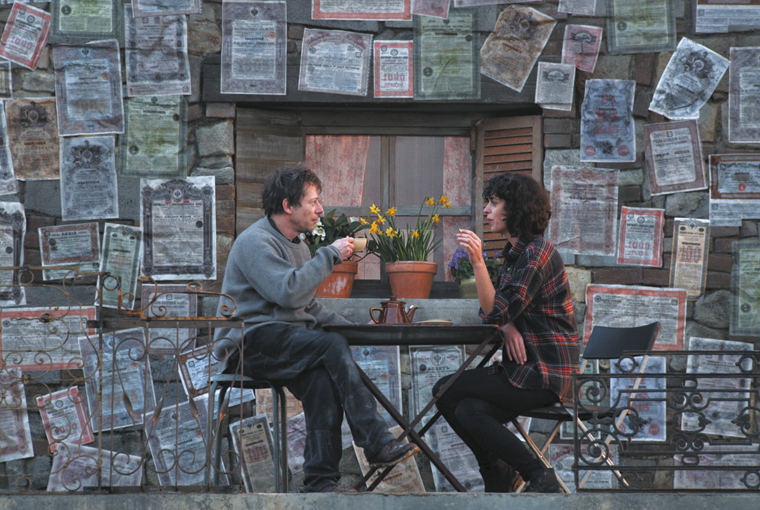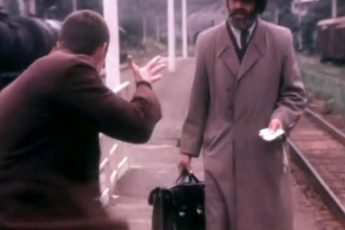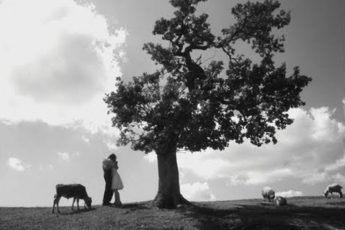Courtyard Visions
Otar Iosseliani’s Winter Song (Chant d’hiver, 2015)
Vol. 60 (December 2015) by Moritz Pfeifer
So many things are happening in Otar Iosseliani’s Winter Song that it is difficult to keep track of them all. Strangely though, the veteran director’s latest investigation into the complexities of contemporary urban life never drifts into sentimental overload, notwithstanding its large ensemble cast, episodic characters, interwoven stories, time lapses and a bunch of surreal visual gimmicks. Winter Song proceeds quietly, like the view of a man observing the world from his courtyard window.
Indeed most of Iosseliani’s characters appear to live in and around an old apartment building located in the picturesque Saint Paul neighborhood of Paris. Connecting all of them is an old-fashioned concierge of noble lineage called Rufus. The beheading of one of his ancestors during the French Revolution opens the film and his remnant skull later ends up in the hands of a drinking anthropologist (Amiran Amiranashvili) who also lives in the building. In his apartment, the anthropologist reconstructs the head’s muscles and skin until it ends up looking more and more like Rufus. Iosseliani’s film is full of such peculiar connections, some of them bluntly comedic, like when a woman whose ample country house is seized prepares sardines for dinner by chopping their heads off with a miniature guillotine.
Other episodes resonate more tragically. Homeless beggars (one of them is the famous French clown Pierre Étaix) sporadically populate the scene, and society’s upper echelons are not the only ones risking eviction. A family is driven out of a shantytown, recalling France’s recent closing down of Roma camps and the countless evictions of refugees. More than one episode can be understood as a political double-entendre. In another scene, Rufus and the anthropologist give romantic advice to a park gardener (Baptiste Blanchet) who tries to court a violinist (the jazz musician Fiona Monbet), telling him how he could start a conversation with her about the pathetic boorishness of Beethoven’s 9th. Their mockery of the “Ode to Joy” melody inevitably ridicules the European Union (which has chosen the ode as an anthem), suggesting that joy might not be the first thing coming to mind when European citizens ponder about their government in Brussels.
The revival of Russian expansionism is more explicitly scorned in a sequence following the opening scene set during the French Revolution. Iosseliani abruptly takes the viewer to the 2008 Russo-Georgian war, showing a group of soldiers pillaging invaluable leftovers from a war-torn village. The comparison between the French Revolution on the one hand, and Russian irredentism on the other, may be somewhat audacious. In an interview for Film Comment, Iosseliani wonders why “the French celebrated the bicentennial of the Revolution. The Revolution was a lake of blood flowing, just… blood. But instead of having a day of mourning for the bicentennial, they had a party.”1 The juxtaposition thus reveals a peculiar custom, namely that of celebrating past atrocities as great national achievements; a political reinterpretation of civil war-like conditions for the sake of national unity. Perhaps years from now, Georgia will do like the French: forget about the hundreds of thousands of displaced persons that have come out of the war, choosing instead to commemorate the conflict as a great accomplishment of their independence from Russia…
As a comedy, Winter Song works best in its rediscovery of silent-era slapstick. One of the reasons why the movie’s sophisticated storylines, meanings and characters don’t appear confusing is that Iosseliani can do with little or no dialogue. The many scenes in which the characters wordlessly pursue their routines give the film a slow, almost pre-talkie era rhythm. As for the routines, they too, appear to be threatened, although it is unclear by what. Symbols of decay and destruction abound. A road roller is menacing the tranquility of the tramps; Rufus discovers withering instruments in a garden behind a door opening in a concrete wall. Characters, props, and setting are, if not historically from yesteryear, as with the nobility, somewhat timelessly antiquated. Old bicycles, a gramophone, leather-bound books, artisan tools and even a horse carriage match the characters’ old-fashioned gusto. Perhaps the only threat to Iosseliani’s Parisian wonderland is the unyielding advancement of time.
In what way the film’s willful ignorance of a more modern lifestyle generates a certain kind of nostalgia for something that never existed, is a question better not asked. But even if Iosseliani’s characters are, for the most part likeable, few of them get away unscathed. In the end Iosseliani’s absurdist vision of contemporary city life as a home of misfits and crooks whose only obvious connection with each other is provided by an oddball concierge and a bloodstained skull resembling him, may be more pessimist than it seems. The film’s timeless allure, at least, could also be a sighful observation about the fact that, from the French Revolution to today, not much has changed.




Leave a Comment